
European civilization has been familiar with the black rat much longer than with the gray rat (another name for which is the pasuk). When the pasyuki in the Middle Ages just began to conquer Europe, black rats were already the scourge of agriculture and big cities. It was black rats that were mentioned by ancient authors in their works, that is, the civilized world has known these rodents for several millennia.
Today, after only a few centuries, both in Europe and in Russia, the black rat is less common and in smaller quantities than the gray one. Here, many people may never see representatives of this species in their entire lives, although they huddle next to them in residential buildings, at enterprises and near housing, but in much smaller quantities than pasyuki.
Below in the photo is a black rat:
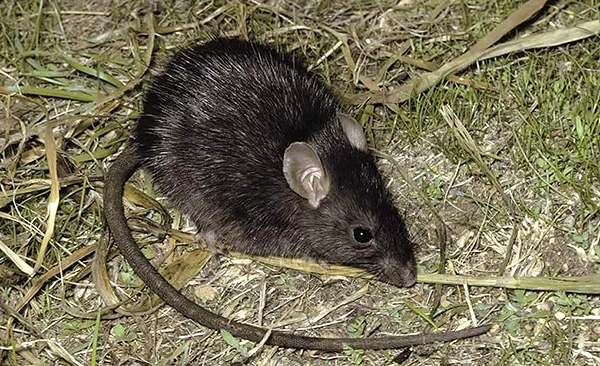
And here is the gray rat, or pasuk:

And if the pasuk today - we can say, the main rodent pest in everyday life and in agriculture in Europe, Russia and North America, then black rats are not so noticeable here, and the scale of their wrecking is much smaller. It seems as if the gray fellowmen are shamelessly crowding out blacks from satisfying and comfortable lands, leaving them only what they themselves neglected.
How is it that black rats in just a few centuries (not so long by evolutionary standards) have turned from the main enemy of the national economy in Europe into a pale shadow of their gray brother? And are they really complete outsiders in the merciless competition with the apiary? Maybe their defeat is only apparent?
The answers to these questions lie in the features of the biology of the species, which let's talk more about ...
The difference in image: how is a black rat different from a gray one?
Outwardly, a black rat is not difficult to distinguish from a gray one, especially if you look at these animals (or their photos) at the same time:
- The black rat is smaller and somewhat slimmer, it has a more elongated muzzle;
- The color of the fur in representatives of this species is darker, corresponding to the name. Although, as we will see later, the color of animals from some populations may be completely different;
- The ears of a black rat are larger - together with a longer nose they make it look like a large mouse.
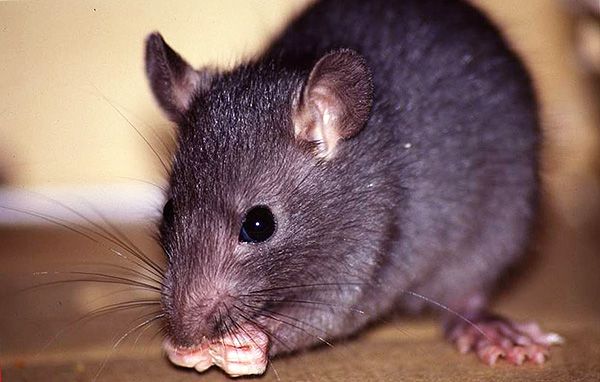
The black rat also has unique anatomical features that only biologists know about. For example, the parietal crests of her skull are curved in an arcuate manner, while in the pasuk they are more even. In living animals of both species, this is not noticeable - such details are found only when studying skulls.
It may seem that the main difference between a black rat and a gray one is the color of the fur. This assumption is true, but not always. The fact is that the species has several color races, and some of them turn out to be even brighter than pasyuki.
For example, in Europe, two races are approximately equally distributed, of which one has a typical black-brown color of fur, darker than that of Pasyuk, and the other is almost light brown with a white belly, similar in color to gophers. That is, the language of the animals of the second race cannot be called black, although they are normal representatives of the species. The species name for them is nothing more than a term to identify the animal.
For example, the photo below shows an individual of a light morph:
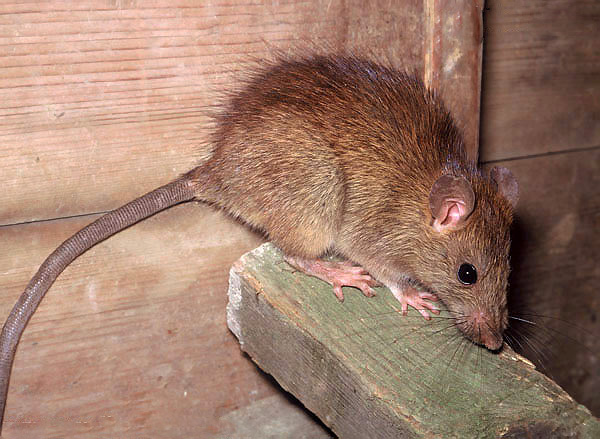
The black rat is inferior in size to the pasuke. The largest representatives of this species reach a length of 22 cm, they have a tail about 29 cm in length, and their body weight reaches 300 grams. For comparison: in Pasyuk 300-320 grams for an adult animal is the norm, and individual males can eat up to 400 grams.
On a note
By the way, another important difference between a black rat is that its tail is always longer than its body. In gray, the length of the tail is always less than the length of the body.
Today, a very interesting fact has been established: under the name "black rat" there are actually four double species. Outwardly, they are no different from each other, have no anatomical differences, lead the same way of life. But their offspring when crossing is less prolific and viable than two representatives of the same species. Moreover, due to the fact that such descendants quickly degenerate and rats survive from “clean lines”, the double species themselves are constantly genetically isolated, although they remain outwardly identical.
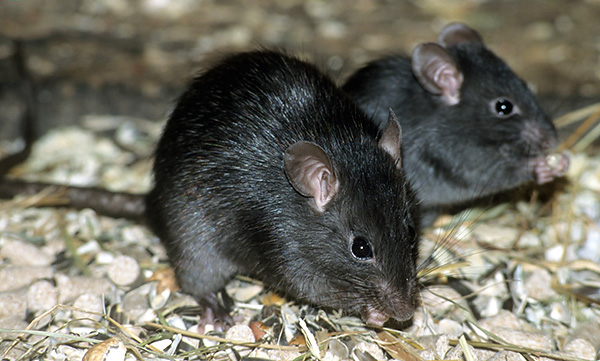
However, some scientists do not fully agree with the allocation of four independent species of black rats. They speak only about karyotypic forms.
As a result, there is one of the interesting phenomena that nature is so rich in: the ranges of such twin species can intersect geographically, and in one territory the externally indistinguishable individuals of black rats can live side by side without giving viable offspring. At the same time, representatives of different color races of the same species, well distinguishable from each other (black and yellow), easily interbreed, and their offspring retain fertility and vitality.
It is interesting
The phenomenon of double species is widespread in nature. He became known to researchers relatively recently, after the introduction of genetic research methods into practice. Before that, it was impossible to differentiate representatives of such species from each other, since they have neither external nor anatomical differences. Methods of genetic research made it possible to unequivocally find differences in the genotype sufficient to isolate animals into different species.
For example, after conducting relevant studies, it turned out that the most dangerous type of Anopheles gambiae malaria mosquito is, in fact, a group of 16 isolated species that are completely identical in appearance. But black rats turned out to be even more unique: their twin species differ not only in individual genes, but even in the number of chromosomes.
Lifestyle and behavior
In their way of life, black rats stand out little among rodents in general and are generally typical rats. They can live in a variety of biotopes, quickly adapt to changing living conditions, and with equal ease populate both natural and man-made landscapes.
They are also characterized by several unique biological features:
- They rarely dig holes. In nature, these animals prefer to settle among stones, in nests on trees, under logs, in the cavities between the foundation of the building and the soil layer, including in parks near monuments and fountains. Only in the complete absence of natural shelters can they dig holes for themselves, but in general they are not earthen rodents;

- These animals live very willingly on trees. They climb perfectly on vertical surfaces; they themselves build spherical nests, similar to magpies, from branches. In the tropics, rat populations are known that have not descended from trees to land for generations. Moreover, they can live both on coniferous trees and deciduous, including palm trees;

- The black rat is thermophilic; in natural biotopes, it lives only within the tropical and subtropical zones. All year round, in the middle zone of Russia, it does not inhabit human settlements;

- On the contrary, in the tropics, these animals actively go into natural biotopes, easily adapt to them and break ties with human housing. In this they differ from the pasyuki, more attached to the person, and precisely because of this, they were able to settle with great speed on many deserted islands of Oceania. In the tropical zone around the world, black rats are more numerous and wider than gray;

- Black rats are quite conservative when resettled, more attached to one place than pasyuki.For this reason, they slowly spread by land, and their habitat increases mainly due to passive resettlement with human transport. In new cities and countries, this species was imported almost always on merchant ships.

Like gray rats, black live in small groups, usually family groups, in which there is one dominant male, several main females and individuals located at the lower steps of the hierarchical pyramid.
Because of their heat lovingness outside the tropical zone, black rats do not breed in the cold season, even if they live next to humans in heated rooms. This, by the way, is one of the factors due to which black rats are replaced by gray ones - the latter simply breed faster.
In general, a black rat prefers to lead a nocturnal lifestyle, but next to a person quickly adapts to the rhythm of his activity and switches to such daily activity that is most beneficial to her.
What does a black rat eat?
By its gastronomic preferences, the black rat is, so to speak, a larger rodent than the pasuk. The basis of her diet is plant foods, mainly grains, fruits and vegetables, nuts, green parts of plants. She does not have such a high demand for animal food as the Pasyuk, although if possible she will not fail to feast on insects, bird eggs or milk. Purposefully, these animals do not catch amphibians or, for example, ducklings, which is known for pasyuki.
Nevertheless, on the oceanic islands it is black rats - the main scourge of birds nesting in the sand or in low bushes. Several sad examples are known when these animals led to the complete extinction of entire species, simply ruining their nests and eating eggs.
In the photo - a rat-ravaged nest:
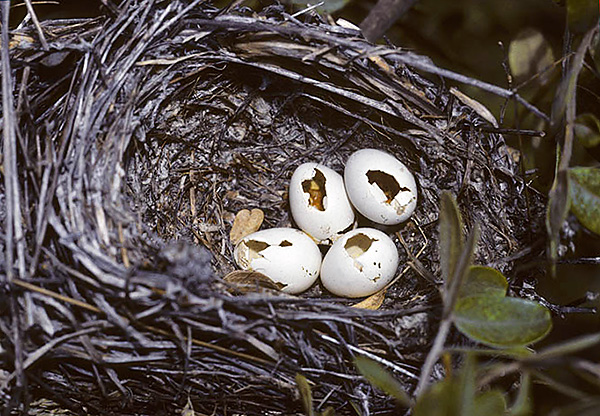
On a note
Rats severely affect ocean bird populations - albatrosses and petrels. These species nest in large colonies on the remote islands of the Indian and Pacific Oceans, where there are no predatory animals at all. Appearing here, black rats learned to attack the chicks right in the nests, gnawing their paws and skin. According to ornithologists, up to 30% of the chicks in the colonies die because of rats, and this poses a threat to the well-being of the species in general.
Examples are also known when black rats, accidentally introduced into new areas, led to a reduction in the populations of large snails that they constantly hunt.
At the same time, these rodents are very picky in food. Able to eat different foods, in each particular place of their habitat they choose a diet composition that, on the one hand, ensures a normal balance of nutrients and vitamins, and on the other hand, avoids the risk of poisoning. In the future, the animals disciplinedly adhere to the chosen diet.
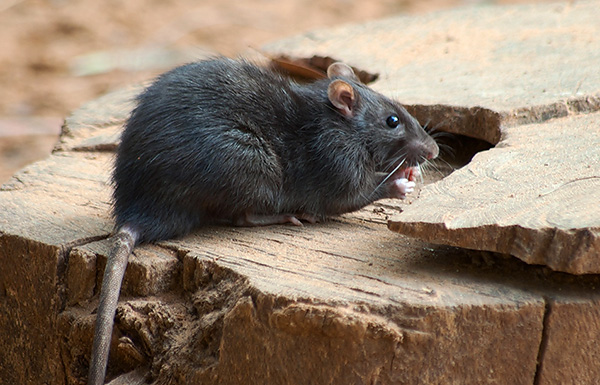
Partly for this reason, black rats are difficult to destroy with the help of poisons - animals are not particularly willing to taste new foods, including poisoned baits.
In addition, black rats are generally more resistant to poisons than pasukas.
One animal eats about 15 grams of food per day and drinks about the same amount of water. In general, in nature, black rats are less dependent on open water sources than their gray counterparts.
Habitat
The black rat is distributed almost throughout the world, it is not only in Antarctica and in the far North. Nevertheless, its range in many places is severely torn, in some places these animals are very rare, or they can not be found outside of human habitation.
For example, in Russia, a black rat is rigidly attached to cities, it settles on agricultural land only with regular crop rotation, does not penetrate into the wild in the temperate zone, and does not affect it. But in the subtropics - in the Caucasus and in the Crimea - wild populations of this species are known that are not related to human housing.Scientific studies show that black rats lived here long before humans appeared and are a relict species.
Interestingly, the vast majority of black rat populations in temperate climates are concentrated in port cities. This is due to the fact that the animals themselves willingly settle on river and sea vessels, but do not travel far by land, their passive resettlement with goods prevails here.
Having accidentally landed in a new city, animals settle in it, become numerous, but do not expand their presence in the region. For example, in the UK, black rats in large quantities inhabit precisely port cities, while gray rats “capture” the inner regions. In another example, a few thousand kilometers to the east, in Tatarstan, there are most black rats in Kazan and in Naberezhnye Chelny, and in the villages far from the rivers there are practically none.
In general, black rats have a special relationship with water transport. According to statistics, 75% of rodents on any ship are just them, and the remaining 25% are pasyuki and mice. This is mainly due to the preferred diet of animals: pasyuki don’t find enough meat on ships, mice suffer from grain shortage here, and black rats feel at ease on garbage and breadcrumbs.
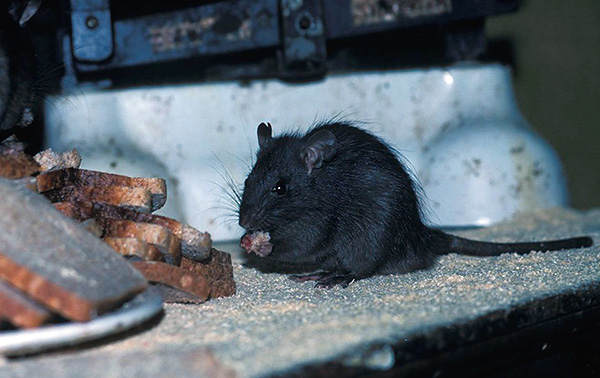
But on the “shore” of black rats another addiction manifests itself: they gravitate to height and dry habitats. You will not find them in damp basements, there are none in sewers where pasukas reign, but they also actively populate dry attics, spaces above false ceilings, the last floors of buildings behind plasterboard partitions. In the old days they created whole rat cities in the thatched roofs of village shacks. For this, by the way, in some places they are called "roofing rats."
In the tropics, the situation is different. Here, a black rat actively inhabits natural biotopes, almost anything from semi-deserts and mountainous rocky slopes at an altitude of 1,500 m above sea level to a selva of tropical rainforests and mangroves. But it is especially numerous on agricultural lands - in rice fields, fruit plantations, peanut farms.

On a note
In India and China, a natural phenomenon known as Mautam, or “the death of bamboo,” is known. It is connected with the fact that once every 48 years a population explosion of the number of black rats takes place, acquiring the character of an invasion, and millions of animals eat almost all the falling bamboo seeds. Because of this, the bamboo forest does not grow again next year. Scientists believe that this is a natural process that regulates bamboo populations, although for the Chinese and Indians themselves, such an event is more like an environmental disaster.
But the main feature of the spread of the black rat is a sharp reduction and fragmentation of its range in Europe over the past few centuries. In many cities, the species has become rare, and in some places it has disappeared completely. This is due to many factors - and the crowding out of black rats with gray, and with the improvement of means to combat rodents, and with an increase in the general level of sanitation. Moreover, people spend huge amounts of money on fighting black rats.
Old "friend" of man
The homeland of the black rat is considered to be East and Southeast Asia, from Vietnam to Afghanistan. In the Mediterranean and the Middle East, it appeared back in the Pleistocene era, when mammoths trampled underfoot the ice tundra of Yakutia, and Neanderthals ruled in modern Spain, Greece and Italy.
This species was the first to populate a person’s housing even when the housing itself was a simple hut and cave. And as cities developed, rats became more and more "civilized."
It was black rats that caused the first outbreaks of the plague pandemic in Europe. In nature, settlements of this species are natural reservoirs of the plague pathogen; hence, animals easily bring plague bacilli into cities.Directly a person is infected with plague by fleas, before which they bite sick rats.

In general, the most devastating plague pandemics in medieval Europe arose after the Pasyuk invasion. However, the townspeople did not particularly distinguish between these two species, and therefore the black rats that were more familiar to them for a long time (if not forever) became a symbol of death, unsanitary conditions and “gloomy” time.
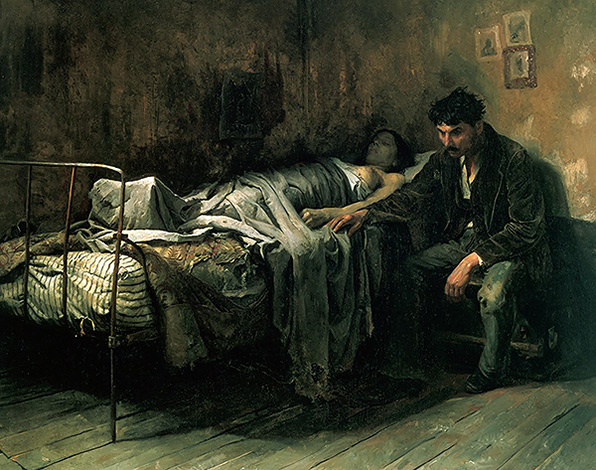
Before the advent of Pasyuk, black rats were the main pests of agricultural stocks throughout Europe and Asia. In German cities, for the destruction of a large number of these pests gave bonuses, there were even days of prayer for getting rid of rodents.
These measures, however, did not help much, and even today, being armed with the most effective poisons and ingenious devices, people with great difficulty manage only to keep the number of rats within certain limits. Significantly more effective than all poisons and traps, the black rat is suppressed by its closest relative - the pasuk.
Complicated relationships with relatives, or why black rats retreat
In those cities in which gray rats penetrate, a decrease in the number of their black counterparts is very clearly noticeable. Pasyuki seem to expel relatives, although in reality there is no direct pursuit of one species by another, and when meeting animals behave quite in a good neighborly manner.
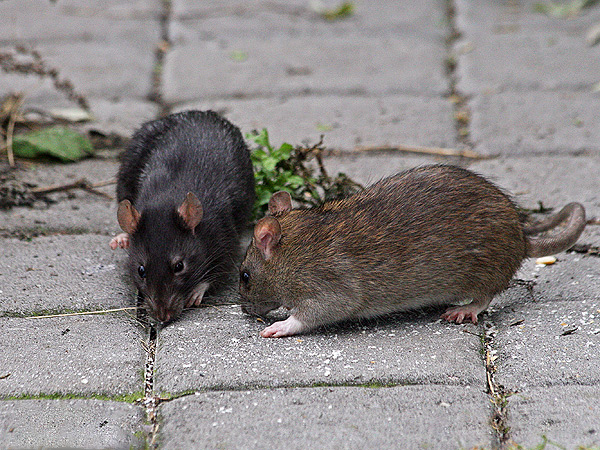
The point here is interspecific competition. Where Pasyuki settle, they find and eat food faster and more actively, due to their high activity they occupy the best and safest shelters, and expand the settlement zone faster. In addition, gray rats are more fertile: they breed all year round, in each litter the female has about 10 cubs (versus 5 in the black). Gray rats simply do not leave black food and normal shelters, and the latter more often die from predators or during deratization measures.
By the way, in any city, ecologists notice a characteristic picture: large gray rats populate the lower floors of buildings, sewers, basements, parks, gardens and kitchen gardens, and the remains of the black rat population desperately cling to the attics and (if there is a port in the city) ships on the water, which pasyuki do not particularly favor with their attention.
In the tropics, the situation is the opposite: here the winner in the competition is the black rat, more adapted to life on agricultural lands outside of human housing.
At the same time, competition between black and gray rats does not occur in the natural habitat, since these species occupy different ecological niches. Pasyuki settle near the water, and black rats live in drier biotopes, as a result they rarely live side by side and they do not have to compete either for food resources or for places for shelters.
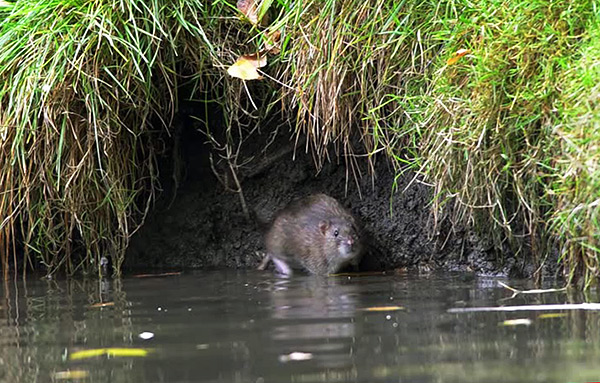
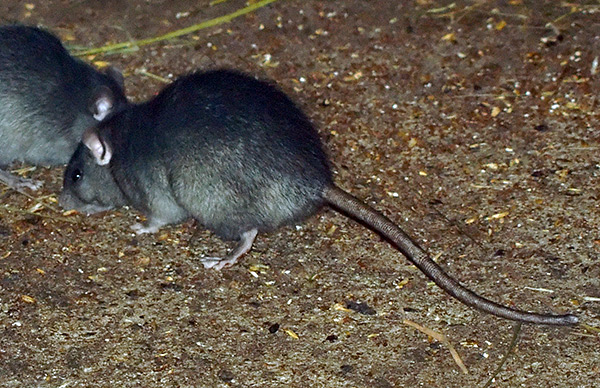
The fact is the fact: today the black rat is considered one of the most numerous and widespread animal species in the world in general. So, its “loss” to the pasuku is local, manifesting itself only in a temperate climate. Having lost here to the gray rat in the struggle for human housing, she confidently wins the competition in the wild in the tropics, and therefore there is no clear winner in this competition yet.
Decorative black rats - are they really black?
And finally, another interesting nuance: decorative black and black with white rats are the home forms of the gray rat, and the black color of the fur was obtained as a result of artificial selection and selection. Since the dark color of the coat in gray rats dominates over the white, it is not difficult to breed animals with black tones in color, and breeding with them is relatively quick.
By the way, thanks to the breeding rate, numerous breeds of decorative rats have been bred today. For example, in the photo below - a Rex breed rat, in which the hair is slightly curled:
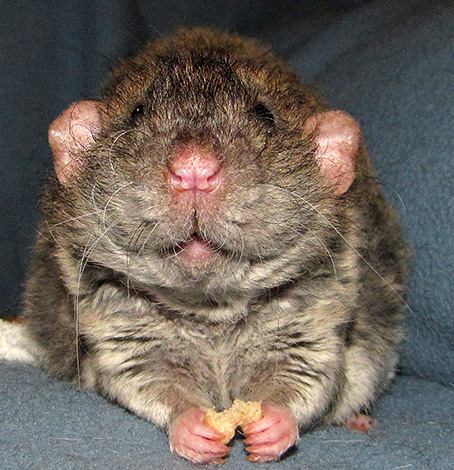
And then in the picture - the so-called naked rat:

On a note
Tricolor rats are unique in their kind.The fact is that in rats the gene encoding the presence of the third color in the coloration is not inherited, and therefore this coloring is due only to random mutations. Tricolor rats are very rare; today only a few of these individuals are known all over the world. Black rats that are not breeding work are not three-color at all.
Real black rats are not kept in captivity, you can buy it at the poultry market or at the pet store just a decorative pasuk with completely black color or separate black spots on the body.
Interesting video: black rat in its natural habitat
And here is a black rat in a cage




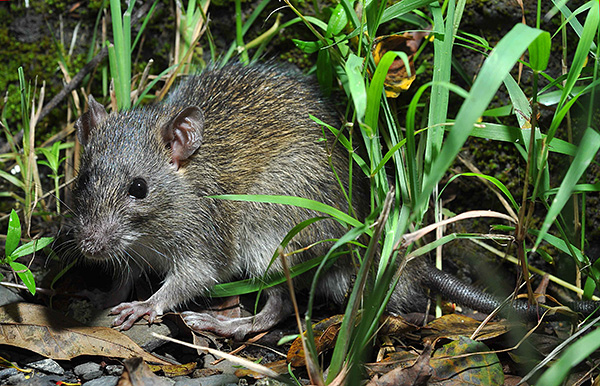


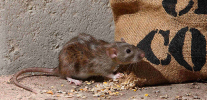

Thanks for the article, it was really interesting to read.
And also - rat-runners with experience often pick up Pasyuk children. If you start taming at a very young age, it turns out a little nervous, but quite tame little animal. There were no successful cases of taming black rats - the beast remains wild, can live comfortably in a cage, but it does not go to the hands. Psyuk's psyche and intelligence are uniquely more flexible and give them a clear advantage.
I had a very special rat, her name was Chora. She was sooooo tame. When I took her in my arms, she deliberately froze (not from fear, I would understand) and sat until I let her go. In a cage, a crap strictly in one corner. I didn’t gnaw at anything, and all this time I was looking for a similar rat. But I did not find anything similar, but it turns out that this is just Rattus rattus (Black Rat). Black rats are tamed very strongly, or not tamed at all. And the pasyuki - neither there nor here, are constantly semi-wild half-handed.
I picked up a black rat cub (07/20/18). Eyes open, trying to wash, drinking milk. I will gladly give it in good hands.
Regarding the carriers of the disease: in fact, these are not rats that carry diseases, but rather, people are carriers of diseases for rats. Even the easiest diseases for us, such as a cold, are able to destroy the animal within two days. Rats are very sensitive to diseases, even to those for which a person has already developed immunity. Regarding the plague in medieval Europe, it has already been proven that the plague was carried by a special kind of flea, which was found in public at that time (this was due to the poor sanitary situation). Rats could not even be carriers of these fleas, since lice and lice eaters inhabit rats from parasites. Fleas on rats do not settle.